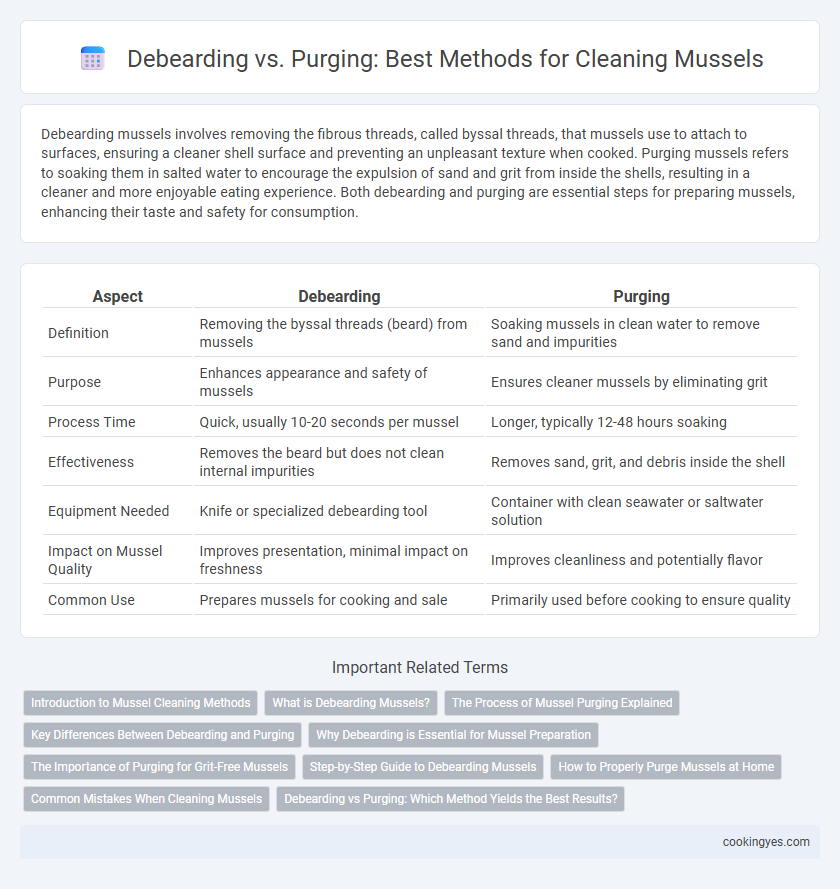Debearding mussels involves removing the fibrous threads, called byssal threads, that mussels use to attach to surfaces, ensuring a cleaner shell surface and preventing an unpleasant texture when cooked. Purging mussels refers to soaking them in salted water to encourage the expulsion of sand and grit from inside the shells, resulting in a cleaner and more enjoyable eating experience. Both debearding and purging are essential steps for preparing mussels, enhancing their taste and safety for consumption.
Table of Comparison
| Aspect | Debearding | Purging |
|---|---|---|
| Definition | Removing the byssal threads (beard) from mussels | Soaking mussels in clean water to remove sand and impurities |
| Purpose | Enhances appearance and safety of mussels | Ensures cleaner mussels by eliminating grit |
| Process Time | Quick, usually 10-20 seconds per mussel | Longer, typically 12-48 hours soaking |
| Effectiveness | Removes the beard but does not clean internal impurities | Removes sand, grit, and debris inside the shell |
| Equipment Needed | Knife or specialized debearding tool | Container with clean seawater or saltwater solution |
| Impact on Mussel Quality | Improves presentation, minimal impact on freshness | Improves cleanliness and potentially flavor |
| Common Use | Prepares mussels for cooking and sale | Primarily used before cooking to ensure quality |
Introduction to Mussel Cleaning Methods
Debearding and purging are essential mussel cleaning methods to ensure seafood safety and quality. Debearding involves removing the fibrous beard or byssal threads attached to the shell, preventing grit and contaminants, while purging allows mussels to expel sand, mud, and other impurities by soaking them in clean water. Efficient mussel cleaning enhances flavor, texture, and consumer safety, making these practices critical in seafood preparation and aquaculture.
What is Debearding Mussels?
Debearding mussels involves removing the fibrous byssal threads, or "beard," that mussels use to anchor themselves to surfaces. This process is essential for ensuring mussel shells are clean and safe for cooking, as the beard can trap debris and bacteria. Unlike purging, which aims to clear the mussel's digestive system by soaking in clean water, debearding targets external cleaning for better freshness and presentation.
The Process of Mussel Purging Explained
Mussel purging involves immersing mussels in clean seawater or a saltwater solution to stimulate the expulsion of sand, grit, and impurities from their digestive tracts, ensuring a cleaner final product. This process typically lasts between 12 to 48 hours, depending on water temperature and mussel size, and requires aerated conditions to maintain mussel vitality. Unlike debearding, which removes the fibrous byssal threads for easier cooking, purging targets internal cleanliness by leveraging the mussel's natural filtering system.
Key Differences Between Debearding and Purging
Debearding mussels involves the physical removal of byssal threads, which are fibrous filaments that mussels use to attach to surfaces, ensuring a cleaner shell surface and preventing these fibers from affecting cooking and eating. Purging mussels refers to soaking them in clean, cold water to expel sand, grit, and impurities from their digestive systems, enhancing the mussels' taste and safety for consumption. The key difference lies in debearding targeting external cleaning by removing the beard, while purging focuses on internal cleansing to eliminate ingested contaminants.
Why Debearding is Essential for Mussel Preparation
Debearding is essential for mussel preparation because it removes the fibrous byssal threads that mussels use to attach to surfaces, ensuring cleaner and safer consumption. This process not only improves the texture and appearance of the mussels but also prevents any gritty or unpleasant residue from affecting the final dish. Proper debearding enhances the overall culinary quality, making it a crucial step before cooking or purging mussels.
The Importance of Purging for Grit-Free Mussels
Purging mussels is essential for removing sand and grit from their digestive systems, ensuring a clean and pleasant eating experience. Unlike debearding, which involves removing the fibrous byssal threads, purging focuses on flushing out internal impurities by soaking mussels in clean, cold water. This process significantly reduces the risk of consuming gritty residue, making purged mussels superior for culinary use.
Step-by-Step Guide to Debearding Mussels
Debearding mussels involves removing the fibrous beard by grasping and pulling it firmly toward the hinge of the shell, ensuring the mussel's freshness and preventing grit contamination. This step-by-step cleaning method is crucial before cooking, as it eliminates unwanted fibers that mussels use to attach to surfaces. Proper debearding enhances the texture and safety of mussels, while purging primarily flushes out sand and impurities from mussel guts over several hours in clean, cold water.
How to Properly Purge Mussels at Home
Properly purging mussels at home involves soaking them in cold saltwater, ideally 4 tablespoons of sea salt per liter, for 20 to 30 minutes to encourage the mussels to expel sand and grit. Changing the water halfway through the purging process helps remove additional impurities, ensuring cleaner shellfish. Avoid using freshwater or removing the beard before purging, as these steps can kill the mussels or reduce their shelf life.
Common Mistakes When Cleaning Mussels
Common mistakes when cleaning mussels include neglecting to debeard the mussels, which can leave fibers that affect texture and eating experience. Purging mussels improperly, such as using saltwater that is too warm or not allowing enough time for sand and grit to be expelled, often results in gritty shells. Failing to inspect and discard open or damaged mussels before cleaning also risks contamination and poor taste.
Debearding vs Purging: Which Method Yields the Best Results?
Debearding mussels involves removing the fibrous byssal threads to ensure cleaner shells and reduce grit, while purging focuses on cleansing the mussel's digestive tract by soaking them in clean water to eliminate sand and impurities. Studies show that debearding provides immediate physical cleanliness, enhancing cooking and eating quality, whereas purging contributes to improved flavor and safety by expelling internal contaminants. Combining both methods often yields the best culinary results, maximizing cleanliness and taste in mussel preparation.
Debearding vs purging for mussel cleaning Infographic

 cookingyes.com
cookingyes.com